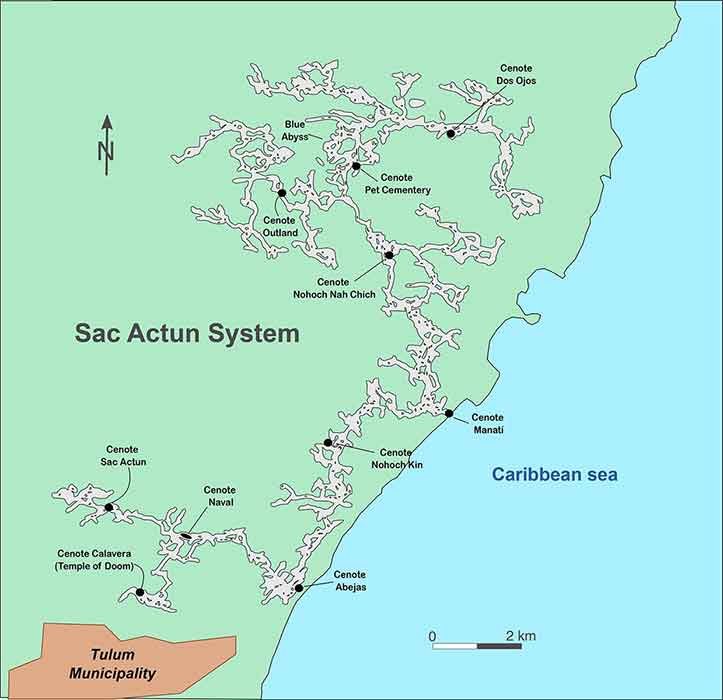Nestled beneath Mexico’s Yucatán Peninsula lies Sac Actun, the world’s longest known underwater cave system, stretching over 368 kilometers (approximately 229 miles) with depths reaching up to 120 meters (394 feet). The name “Sac Actun” translates to “white cave” in Mayan, reflecting the system’s pale limestone formations.
This extensive network is located within the Tulum municipality and is accessed through numerous cenotes—natural sinkholes—that dot the region. These cenotes not only provide entry points for exploration but also hold significant cultural and environmental importance.
Ecological and Archaeological Significance
The Sac Actun underground river system is a treasure trove of biodiversity and archaeological wonders. The cenotes connected to this system have been pivotal in understanding the region’s prehistoric life. Notably, the discovery of “Naia,” a teenage girl’s skeleton dating back over 12,000 years, provided invaluable insights into early human inhabitants of the Americas. Remains of extinct species, such as the mastodon, have been unearthed within these submerged caves, offering a glimpse into the Pleistocene epoch.

Environmental Threats to the Sac Actun Underground River System
Despite its significance, Sac Actun faces numerous threats:
- Urban and Tourist Development: Rapid expansion in areas like Tulum has led to deforestation and habitat disruption. The construction of infrastructure, hotels, and resorts often proceeds without comprehensive environmental assessments, jeopardizing the cave system’s integrity. Moreover, inadequate wastewater management results in pollutants seeping into the aquifer, affecting water quality and the diverse ecosystems reliant on it.
- Large-Scale Infrastructure Projects: The Tren Maya railway project aims to boost connectivity across southeastern Mexico but poses environmental concerns. Parts of its route traverse sensitive areas of the Sac Actun system. The construction involves placing pillars and tracks over fragile limestone formations, increasing the risk of collapses, altering groundwater flows, and fragmenting habitats of endangered species like the jaguar.
- Aquifer Pollution: The infiltration of untreated wastewater introduces nitrates, phosphates, and other chemicals into the aquifer. This contamination can lead to algal blooms, deteriorating water quality, and posing health risks to both humans and wildlife dependent on the aquifer.
Conservation Efforts
Protecting Sac Actun requires coordinated efforts from various governmental agencies:
- National Water Commission (CONAGUA): This federal entity oversees water resource management in Mexico, regulating usage and ensuring quality to prevent overexploitation and contamination.
- National Commission of Protected Natural Areas (CONANP): Tasked with conserving ecosystems and biodiversity within protected zones, CONANP’s mandate includes areas like the Sian Ka’an Biosphere Reserve, which encompasses parts of the Sac Actun underground river system. However, challenges persist due to ongoing development and infrastructure projects.
Enhanced enforcement of environmental regulations, comprehensive impact assessments for new developments, and collaboration with local communities are crucial steps toward preserving this natural wonder. By balancing development with conservation, Mexico can safeguard Sac Actun for future generations while promoting sustainable tourism and economic growth.
Discover more from Riviera Maya News & Events
Subscribe to get the latest posts sent to your email.

